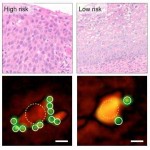 In recent times there have been a clutch of devices that have brought disease diagnosis to our mobile phone. For instance, Cupris offer a smartphone add on that can be used to detect various ear infections.
In recent times there have been a clutch of devices that have brought disease diagnosis to our mobile phone. For instance, Cupris offer a smartphone add on that can be used to detect various ear infections.
You also have the SNIFFPHONE project, which looks at your breath for signs of disease.
The latest such innovation comes from the Massachusetts General Hospital, who have developed a cool new smartphone device that uses holographic technology to collect microscopic images for analysis of cells and tissues for cancer.
“The global burden of cancer, limited access to prompt pathology services in many regions and emerging cell profiling technologies increase the need for low-cost, portable and rapid diagnostic approaches that can be delivered at the point of care,” say the researchers in a report on the project. “The emerging genomic and biological data for various cancers, which can be essential to choosing the most appropriate therapy, supports the need for molecular profiling strategies that are more accessible to providers, clinical investigators and patients; and we believe the platform we have developed provides essential features at an extraordinary low cost.”
Digital Diffraction Diagnosis
The device is known as the D3 (for digital diffraction diagnosis) and comes with an imaging module that clips onto a smartphone to record high-res images with the camera on your phone.
The system is able to record data on over 100,000 cells from a single image of a blood or tissue sample. This data can then be sent off for analysis to a secure graphic-processing server, with the results swiftly returned to the user.
The analysis explores the diffraction patterns of microbeads that are known to bind to particular cancer related molecules, thus allowing the device to predict the onset of cancer.
The system was put through its paces and managed to detect cancerous cell lines with a comparable accuracy level to that of the best molecular profiling currently available. What’s more, the analysis was performed in less than an hour for around $1.80 per assay, with this price expected to fall as the system is refined.
“We expect that the D3 platform will enhance the breadth and depth of cancer screening in a way that is feasible and sustainable for resource limited-settings,” the researchers say. “By taking advantage of the increased penetration of mobile phone technology worldwide, the system should allow the prompt triaging of suspicious or high-risk cases that could help to offset delays caused by limited pathology services in those regions and reduce the need for patients to return for follow-up care, which is often challenging for them.”
The team hope to further develop the platform in future to advance its capabilities.
“The research team will: 1) investigate the D3 platform’s ability to analyze protein and DNA markers of other disease catalysts, including infectious agents and allergens; 2) integrate the software with larger databases; and 3) conduct clinical studies in settings such as care-delivery sites in developing countries or rural settings and for home testing with seamless sharing of information with providers and/or clinical investigators.” they say.
Remarkable. A very exciting time at the moment.
It certainly is Nick. If only half of these mobile innovations obtain mainstream status then it will achieve some fantastic things.